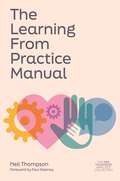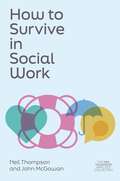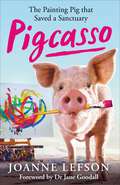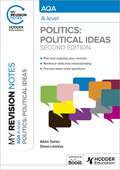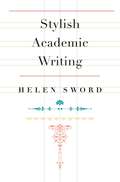- Table View
- List View
Paramedic Pocketbook of Prescription Medications
by Rose MathesonReference pocketbook containing common medications prescribed to patients to facilitate identification and revealing potential interactions, overdose symptoms, and common call outs Easy to navigate and truly pocket-sized, the Paramedic Pocketbook of Prescription Medications covers common medications and their possible presentations, highlights risk of causing harm, and goes over mechanism of action, use, and potential risks for each. Key features: Concise presentation of a wide range of medications, accessible even to those with a limited pharmacological background Brief overview of drug legislation and paramedic practice Includes special circumstances in paediatrics, the elderly, and individuals experiencing kidney injury and disease, hepatic failure, pregnancy and breastfeeding, and palliative care Highlights which conditions or medications have different prevalence or effects in different ethnic groups Paramedic Pocketbook of Prescription Medications is an essential guide for emergency services personnel and first responders to carry with them for easy reference and peace of mind.
The Learning From Practice Manual (The Neil Thompson Practice Collection)
by Neil ThompsonNeil Thompson sets out what you really need to know about supporting further learning during placement and practice. Stripping away the confusion and anxiety about 'what next?', this manual goes back to the core theories of how learning works in the first place, and how you can synchronise that with values and reflective practice to help your students and colleagues reach their professional goals. Summaries illustrate and reinforce the guidance, creating a set of easy-to-follow strategies for effective workplace development mentoring.Accessible explanations guide you through the theory and practice, covering everything from fostering a learning environment to troubleshooting difficulties and encouraging a culture of self-directed learning. Grow your mentoring skills and help your colleagues get to grips with not just what to learn, but how to learn it and make it stick.
How to Survive in Social Work (The Neil Thompson Practice Collection)
by Neil Thompson John McGowanSocial worker. You're a helping hand, a rock in the tempest, a friendly face through the hard times, and a catalyst for change. But what about you? How do you keep going when the pressure just keeps rising?In this no-nonsense handbook, Neil Thompson and John McGowan distil years of social work expertise into key strategies to overcome the challenges that come with the profession. Each chapter is full of clear, practical advice on staying resilient in the face of tough situations, whether they're political, social, or economic. Handy frameworks and expert advice will strengthen your practice and give you a solid structure to build on, helping you fulfil your potential as a social worker and provide better support for your clients. Social work is tough, but with the guidance and support in this book you can learn to tackle the challenges and thrive as a force for change.
The Social Worker's Practice Manual (The Neil Thompson Practice Collection)
by Neil ThompsonAn essential handbook for students and experienced social workers alike, this practical guide filters out the jargon and sets out what you really need to know. 30 easy-to-follow chapters delve into topics ranging from holistic thinking to effective record keeping, all rooted in Neil Thompson's extensive hands-on experience. Complicated subjects such as cultural sensitivity and managing conflict are discussed thoughtfully and pragmatically, helping you understand the roots of tricky situations and find effective solutions. Each section successfully combines theory and practice to give a holistic view of social work that can be tailored to help each unique client. Over 45 years of experience distilled into one manual for success.
Survival: June-July 2024
by The International Institute for Strategic Studies (IISS)Survival, the IISS’s bimonthly journal, challenges conventional wisdom and brings fresh, often controversial, perspectives on strategic issues of the moment.In this issue: François Heisbourg considers how Europeans might prepare for a disrupted US security commitment if Donald Trump becomes president again – free to read Lanxin Xiang warns that the Biden administration’s democracy-versus-autocracy framework increases the risk of conflict between the United States and China Daniel Byman argues that the Gaza war will leave both Israel and Hamas worse off – free to read Hanna Notte assesses the impact of the Russia–Ukraine war on multilateral nuclear forums and on the broader nuclear order And ten more thought-provoking pieces, as well as our regular Book Reviews and Noteworthy column. Editor: Dr Dana AllinManaging Editor: Jonathan StevensonAssociate Editor: Carolyn WestEditorial Assistant: Conor Hodges
Paramedic Pocketbook of Prescription Medications
by Rose MathesonReference pocketbook containing common medications prescribed to patients to facilitate identification and revealing potential interactions, overdose symptoms, and common call outs Easy to navigate and truly pocket-sized, the Paramedic Pocketbook of Prescription Medications covers common medications and their possible presentations, highlights risk of causing harm, and goes over mechanism of action, use, and potential risks for each. Key features: Concise presentation of a wide range of medications, accessible even to those with a limited pharmacological background Brief overview of drug legislation and paramedic practice Includes special circumstances in paediatrics, the elderly, and individuals experiencing kidney injury and disease, hepatic failure, pregnancy and breastfeeding, and palliative care Highlights which conditions or medications have different prevalence or effects in different ethnic groups Paramedic Pocketbook of Prescription Medications is an essential guide for emergency services personnel and first responders to carry with them for easy reference and peace of mind.
Embracing Ethnography: Doing Contextualised Construction Research
This book calls for those interested in robust construction research to embrace ethnography – in all its forms, including rapid ethnographies, ethnographic-action research, autoethnography, as well as longer-term ethnographies.The diversification of ethnographic approaches, as well as ethnographers, will lead to rich insights that can advance the industry theoretically and practically. We share experiences, key considerations and recommendations from leading construction ethnographic researchers from around the world to provide discussion, reflection and understanding into doing ethnography in the construction industry.This book is aimed at academics, students, consultants, editors, reviewers, policymakers, funders and others interested in robust research in the construction industry and built environment but will also be useful for those undertaking research within organisations in other industries.
Embracing Ethnography: Doing Contextualised Construction Research
by David Oswald Léon Olde ScholtenhuisThis book calls for those interested in robust construction research to embrace ethnography – in all its forms, including rapid ethnographies, ethnographic-action research, autoethnography, as well as longer-term ethnographies.The diversification of ethnographic approaches, as well as ethnographers, will lead to rich insights that can advance the industry theoretically and practically. We share experiences, key considerations and recommendations from leading construction ethnographic researchers from around the world to provide discussion, reflection and understanding into doing ethnography in the construction industry.This book is aimed at academics, students, consultants, editors, reviewers, policymakers, funders and others interested in robust research in the construction industry and built environment but will also be useful for those undertaking research within organisations in other industries.
Jobs Done By Persons With Disability
by EnAble IndiaEnAble India's document celebrates the achievements of persons with disabilities in the workforce, focusing on job opportunities in its 2020 edition. Acknowledging a wide range of stakeholders—individuals with disabilities, their families, professionals, workplace experts, and supportive companies—the document offers practical guidance on promoting employability. It features analytics, case studies, and best practices for inclusive hiring, alongside job role lists and self-employment options. Notably, it identifies 291 job roles across sectors and maps them to 11 types of disabilities, advocating for workplace solutions that enable accessibility. Serving as a vital resource, the document empowers employers and organizations in the disability sector with insights into fostering inclusive workplaces and emphasizing the value of accessibility and inclusion in employment.
Pigcasso: The painting pig that saved a sanctuary
by Joanne LefsonWhen Joanne Lefson took on a piglet at her animal shelter, the young sow proceeded to eat everything in her stable but a paint brush. In a flash of inspiration, Joanne attempted to introduce the pig to the art of painting - and thus Pigcasso was born. Starting out with a humble canvas on the sanctuary wall, Pigcasso's paintings are now owned by the likes of George Clooney, she has a Swatch watch design partnership, a wine label, and has eclipsed the previous world record holder for animal art. She's been commissioned by Nissan and has had exhibitions in Cape Town, Munich and Amsterdam. More than that, Pigcasso's art funds the food and veterinary services for all the animals at the sanctuary.Pigcasso is the story of this unique pig and of the circumstances that brought her and Joanne together to take the art world by storm and form a unique and unbreakable bond.
My Revision Notes: AQA A-level Politics: Political Ideas Second Edition
by Simon Lemieux Adam TomesMy Revision Notes will engage students with our updated approach to consolidating course content and helping them learn, practise and apply their skills and understanding. Coverage of key content is combined with practical study tips and effective planning strategies to create a guide that students can rely on to build both knowledge and confidence.- Helps students plan and manage their learning independently with our topic-by-topic planner- Encourages students to practise and apply their skills and knowledge with regular 'Now test yourself' sections, refreshed practice questions and answer guidance online- Supports subject-specific exam skills with a new exam skills box at the end of each chapter- Reflects the structure and format of recent exams with refreshed exam-style questions and improved course coverage- Includes content mapped to the specification, streamlined to give students the knowledge they need to help with the exams- Covers content for the Political Ideas component of the AQA specification - Helps students understand key terms with user-friendly definitions and tips throughout, plus a glossary
Using Natural Remedies Safely in Pregnancy and Childbirth: A Reference Guide for Maternity and Healthcare Professionals
by Denise TiranProviding in-depth information on natural remedies that midwives, doulas, GPs and other health professionals can use to advise and inform their clients, this reference guide focuses on safety in their application.The book brings together herbal medicine, homeopathy, essential oils, flower remedies and traditional remedies from other cultures, and applies them directly to pregnancy, childbirth and the postnatal period.Containing an alphabetical listing of 220 remedies covering common uses, contraindications and precautions, adverse effects and interactions, Using Natural Remedies Safely in Pregnancy and Childbirth is a vital resource for healthcare professionals working in conventional maternity care who wish to learn about the safe application of natural remedies.
The Architecture and Geography of Sound Studios: Sonic Heritage (Routledge Research in Architecture)
by Even Smith WergelandThis is a book about sound studios, focusing on their architectural and geographical aspects. It explores how music is materialized under specific spatial and technological conditions and the myths associated with this process.Through ten in-depth studies, it examines the design, evolution and current function of sound studios amidst economic and technological shifts in the music industry. Traditional studios are in flux between the past and future. The industry, while steeped in romanticism and nostalgia, also embraces forward-driven pragmatism and an extensive reuse culture, encompassing heritage audio, building materials and existing buildings. A surprisingly diverse architectural heritage, the most significant feature is the host building, the framework around the studio capsule. Many traditional studios adapt to digitalization with hybrid solutions, reflecting a shift toward smaller, more versatile spaces. In a time when recordings in theory can happen anywhere, destination studios must excel to attract clients, balancing historical legacies with diversification. Although they may be easy to deconstruct, many of the myths endure, sustaining ideas of landmark recordings, unique locations and distinct remnants of sonic heritage. Courtesy of their capacity to keep the past alive in the present, traditional sound studios are best described as museums that work.This book aims to reach scholars and students with an interest in history, theory and preservation, as well as practicing architects and architectural students who wish to find out more about the relationship between sound and space, acoustic design and retrofitting of historical buildings into specialized functions. It also aims to reach practicing musicians, producers, music students and music scholars.
The Architecture and Geography of Sound Studios: Sonic Heritage (Routledge Research in Architecture)
by Even Smith WergelandThis is a book about sound studios, focusing on their architectural and geographical aspects. It explores how music is materialized under specific spatial and technological conditions and the myths associated with this process.Through ten in-depth studies, it examines the design, evolution and current function of sound studios amidst economic and technological shifts in the music industry. Traditional studios are in flux between the past and future. The industry, while steeped in romanticism and nostalgia, also embraces forward-driven pragmatism and an extensive reuse culture, encompassing heritage audio, building materials and existing buildings. A surprisingly diverse architectural heritage, the most significant feature is the host building, the framework around the studio capsule. Many traditional studios adapt to digitalization with hybrid solutions, reflecting a shift toward smaller, more versatile spaces. In a time when recordings in theory can happen anywhere, destination studios must excel to attract clients, balancing historical legacies with diversification. Although they may be easy to deconstruct, many of the myths endure, sustaining ideas of landmark recordings, unique locations and distinct remnants of sonic heritage. Courtesy of their capacity to keep the past alive in the present, traditional sound studios are best described as museums that work.This book aims to reach scholars and students with an interest in history, theory and preservation, as well as practicing architects and architectural students who wish to find out more about the relationship between sound and space, acoustic design and retrofitting of historical buildings into specialized functions. It also aims to reach practicing musicians, producers, music students and music scholars.
Spirit Structures of Papua New Guinea: Art and Architecture in the Kaiaimunucene (Routledge Research in Architecture)
by Michael HirschbichlerThis book investigates the art and architecture of Papua New Guinean spirit structures with a multi-perspectival approach that combines cultural and social sciences with building, architectural, and spatial research. It offers the first comprehensive study of the spirit houses of New Guinea that exists to date.The book’s aim is twofold: First, it aims to investigate the spirit structures and their associated cultural cosmos in detail. For this purpose, a representative selection of traditional buildings and artworks from different regions of Papua New Guinea is documented and analyzed, and theories for their understanding are formulated. In this course, the author develops a spatial theory of anthropological concepts – such as myths, signs, persons, and rituals. Secondly, this analysis is then situated in the broader context of the Anthropocene/Kaiaimunucene. Transforming the historical spirit structures into models for future-oriented cultural imagination, the consequences for contemporary productions of space and ways of worldmaking in light of existential challenges are traced.The book thus offers more-than-human and more-than-secular concepts for building, art, and worldmaking that are of critical importance in the ongoing Anthropocene/Kaiaimunucene. It will be of interest to researchers and students of architecture, anthropology, cultural studies, environmental humanities, and adjacent disciplines.Part I of the book was translated from German by Melanie Janet Sindelar.
Spirit Structures of Papua New Guinea: Art and Architecture in the Kaiaimunucene (Routledge Research in Architecture)
by Michael HirschbichlerThis book investigates the art and architecture of Papua New Guinean spirit structures with a multi-perspectival approach that combines cultural and social sciences with building, architectural, and spatial research. It offers the first comprehensive study of the spirit houses of New Guinea that exists to date.The book’s aim is twofold: First, it aims to investigate the spirit structures and their associated cultural cosmos in detail. For this purpose, a representative selection of traditional buildings and artworks from different regions of Papua New Guinea is documented and analyzed, and theories for their understanding are formulated. In this course, the author develops a spatial theory of anthropological concepts – such as myths, signs, persons, and rituals. Secondly, this analysis is then situated in the broader context of the Anthropocene/Kaiaimunucene. Transforming the historical spirit structures into models for future-oriented cultural imagination, the consequences for contemporary productions of space and ways of worldmaking in light of existential challenges are traced.The book thus offers more-than-human and more-than-secular concepts for building, art, and worldmaking that are of critical importance in the ongoing Anthropocene/Kaiaimunucene. It will be of interest to researchers and students of architecture, anthropology, cultural studies, environmental humanities, and adjacent disciplines.Part I of the book was translated from German by Melanie Janet Sindelar.
Teaching Architecture: The New Age of Digital Design (Routledge Focus on Design Pedagogy)
by Sadiyah GeyerIn the post-COVID era, understanding the profound impact of digital technologies on design pedagogy is crucial. This book delves into experimental design education, showcasing projects utilising technology to transform creative and analytical processes.Emphasising the potential for digital-era technologies to create novel educational opportunities, the book addresses recent global events and their role in minimising educational disruptions in the evolving hybrid educational landscape. Each chapter offers case studies exploring digital technology's influence across architectural education, spanning interior design, urban planning, parametric digital design, architectural conservation, and design analysis. Contributors envision the hybrid virtual design studio’s future and discuss the collaborative role of digital technologies in urban design projects. The book analyses contemporary parametric design processes and machine learning through innovative historical case studies, examining new technologies in architectural conservation.With case studies from diverse locations, including South Africa, Turkey, the UK, and the United States, the book provides a global perspective on the influences and potential futures of digital technologies in architecture. Essential for those interested in the future of spatial design education, this book illuminates the pivotal role of technology in shaping its trajectory.
Our Autistic Lives: Personal Accounts from Autistic Adults Around the World Aged 20 to 70+
by Edited by Alex RatcliffeThis collection of narratives from autistic adults is structured around their decades of experience of life, covering 20s, 30s, 40s, 50s, 60 and 70s+. These are varied and diverse, spanning different continents, genders, sexualities and ethnicities, yet the author highlights the common themes that unite them and skilfully draws out these threads. Each chapter is based on accounts from one age group and includes accounts from people of that age, giving an insight into the history of autism and signifying how gaining a diagnosis (or not) has changed people's lives over time. The book is about ageing with an autistic mind, and helping the reader find connections between neurotypical and neurodiverse people by acknowledging the challenges we all face in our past, present and futures.
Crafting Meaningful Wedding Rituals: A Practical Guide
by Jeltje Gordon-LennoxThe trend towards a more secular culture in Western society means that there can be greater flexibility in a wedding ceremony, but couples are often faced with the challenge of preparing a meaningful celebration outside the traditional religious framework. This hands-on, practical guide demonstrates how to approach and prepare a secular wedding ceremony that honours a couple's relationship with honest vows and rituals true to their shared values. In addition, it provides guidance on structuring a ceremony for couples that come from very different cultural or spiritual backgrounds.Includes the tools necessary for the creation of a ceremony, such as a Ritual Identity Questionnaire, checklists, and many other resources.
Catatonia, Shutdown and Breakdown in Autism: A Psycho-Ecological Approach
by Amitta ShahThis ground-breaking book provides the first detailed clinical analysis of the various manifestations of catatonia, shutdown and breakdown in autistic individuals, with a new assessment framework (ACE-S) and guidance on intervention and management strategies using a psycho-ecological approach. Based on Dr Amitta Shah's lifetime of clinical experience in Autism Spectrum Disorders, and her research in collaboration with Dr Lorna Wing, this much needed book will be a valuable resource for professionals, autistic individuals and their families and carers.
The Business of Maternity Care: A Guide for Midwives and Doulas Setting Up in Private Practice
by Denise TiranThis is a guide for midwives and doulas who want to set up a private maternity-related business. Included is advice on business issues such as marketing and pricing, and debate around the professional, legal and ethical issues. There are also activities and exercises to help the reader set up their business, as well as case studies throughout.
The Interbrain: How Unconscious Connections Influence Human Behaviour and Relationships
by Digby TantamArguing that our brains are wirelessly connected though non-verbal communication, Digby Tantam presents research to show how our brains are linked in unexpected ways and the implications this has for our understanding of criminal behaviour, autism spectrum disorders, relationships and more.
Evidence-Based Assessment in ASD (Autism Spectrum Disorder): What Is Available, What Is Appropriate and What Is ‘Fit-for-Purpose'
by Kenneth AitkenThis practical, research-based book introduces and reviews the evidence-based measures used in the commissioning and auditing of services for people with ASD, where the ability to demonstrate the benefits and effects of support and intervention is increasingly important.
An Employer's Guide to Managing Professionals on the Autism Spectrum
by Integrate Joan Bogden Marcia ScheinerThis is a comprehensive reference guide for managers and colleagues of people with Asperger's Syndrome (AS). Containing detailed descriptions of workplace behaviours, the underlying issues that cause them, and recommendations on how to manage them, this book will help managers and colleagues of people with AS manage behaviours in a respectful way.
Stylish Academic Writing
by Helen SwordElegant data and ideas deserve elegant expression, argues Helen Sword in this lively guide to academic writing. For scholars frustrated with disciplinary conventions, and for specialists who want to write for a larger audience but are unsure where to begin, here are imaginative, practical, witty pointers that show how to make articles and books a pleasure to read—and to write.Dispelling the myth that you cannot get published without writing wordy, impersonal prose, Sword shows how much journal editors and readers welcome work that avoids excessive jargon and abstraction. Sword’s analysis of more than a thousand peer-reviewed articles across a wide range of fields documents a startling gap between how academics typically describe good writing and the turgid prose they regularly produce.Stylish Academic Writing showcases a range of scholars from the sciences, humanities, and social sciences who write with vividness and panache. Individual chapters take up specific elements of style, such as titles and headings, chapter openings, and structure, and close with examples of transferable techniques that any writer can master.

